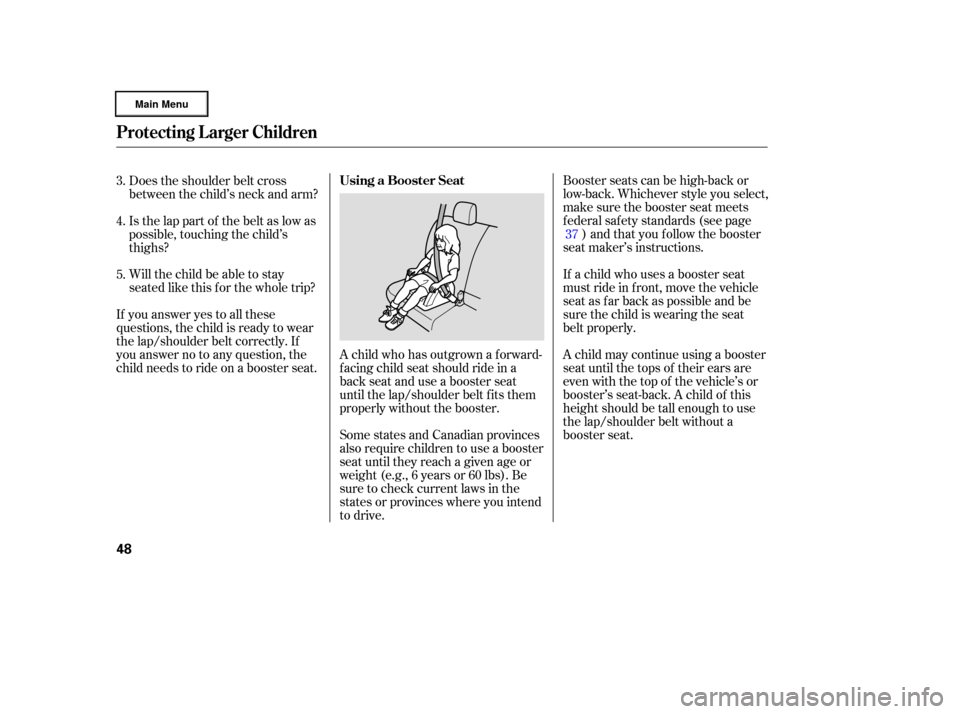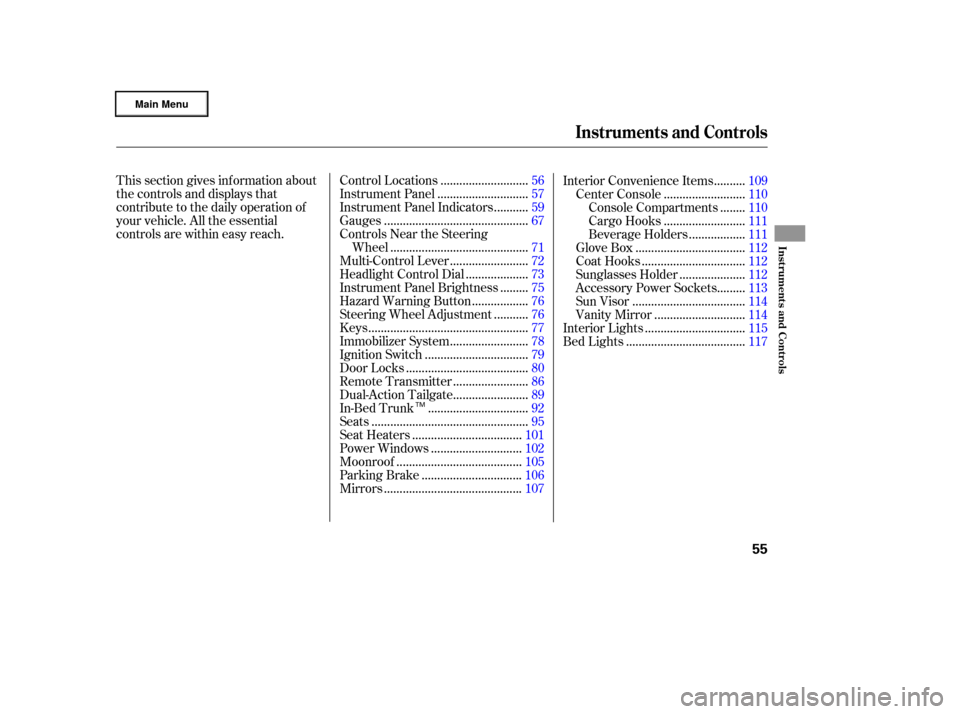Page 51 of 320

Booster seats can be high-back or
low-back. Whichever style you select,
make sure the booster seat meets
f ederal saf ety standards (see page) and that you f ollow the booster
seat maker’s instructions.
If a child who uses a booster seat
must ride in f ront, move the vehicle
seat as far back as possible and be
sure the child is wearing the seat
belt properly.
A child may continue using a booster
seat until the tops of their ears are
even with the top of the vehicle’s or
booster’s seat-back. A child of this
height should be tall enough to use
the lap/shoulder belt without a
booster seat.
Does the shoulder belt cross
between the child’s neck and arm?
Is the lap part of the belt as low as
possible, touching the child’s
thighs?
Will the child be able to stay
seated like this f or the whole trip?
If you answer yes to all these
questions, the child is ready to wear
the lap/shoulder belt correctly. If
you answer no to any question, the
child needs to ride on a booster seat. A child who has outgrown a forward-
f acing child seat should ride in a
back seat and use a booster seat
until the lap/shoulder belt f its them
properly without the booster.
Some states and Canadian provinces
also require children to use a booster
seat until they reach a given age or
weight (e.g., 6 years or 60 lbs). Be
sure to check current laws in the
states or provinces where you intend
to drive.
3.
4.
5.
37
Protecting L arger Children
Using a Booster Seat
48
�����—�
���—�����y�
�������������y���
�(�����������y���������y
Page 58 of 320

This section gives inf ormation about
the controls and displays that
contribute to the daily operation of
your vehicle. All the essential
controls are within easy reach............................
Control Locations .56
............................
Instrument Panel .57
..........
Instrument Panel Indicators .59
.............................................
Gauges .67
Controls Near the Steering
...........................................
Wheel .71
........................
Multi-Control Lever .72
...................
Headlight Control Dial .73
........
Instrument Panel Brightness .75
.................
Hazard Warning Button .76
..........
Steering Wheel Adjustment .76
..................................................
Keys .77
........................
Immobilizer System .78
................................
Ignition Switch .79
......................................
Door Locks .80
.......................
Remote Transmitter .86
.......................
Dual-Action Tailgate .89
...............................
In-Bed Trunk .92
.................................................
Seats .95
..................................
Seat Heaters .101
............................
Power Windows .102
.......................................
Moonroof .105
...............................
Parking Brake .106
...........................................
Mirrors .107 .........
Interior Convenience Items .109
.........................
Center Console .110
.......
Console Compartments .110
.........................
Cargo Hooks .111
.................
Beverage Holders .111
..................................
Glove Box .112
................................
Coat Hooks .112
....................
Sunglasses Holder .112
........
Accessory Power Sockets .113
...................................
Sun Visor .114
............................
Vanity Mirror .114
...............................
Interior Lights .115
.....................................
Bed Lights .117
Instruments and Controls
Inst rument s and Cont rols
55
TM
�����—�
���—�����y�
�����������
�y���
�(�����������y���������y
Page 98 of 320
�µ
See pages f or important saf ety
inf ormation and warnings about how toproperly position the seats and seat-backs. 11 13
Make all seat adjustments bef ore
you start driving.
All models except the RT and the
Canadian LX have a power
adjustable driver’s seat. The RT/LX
model has manual driver’s seat
adjustments (see the next column).
To adjust the seat f orward or
backward, pull up on the bar under
the seat cushion’s f ront edge. Move
the seat to the desired position, and
releasethebar.Trytomovetheseat
to make sure it is locked in position.To change the seat-back angle of the
f ront seat, pull up on the lever on the
outside of the seat bottom.
Once your seat is adjusted correctly,
rock it back and f orth to make sure it
is locked in position.
The f ront passenger’s seat in all
models adjusts manually.
Seats
Manual Seat Adjustments
Inst rument s and Cont rols
95
�����—�
���—�����y�
������
������y���
�(�����������y���
�����y
Page 99 of 320
Make sure to pull the lever upward
or downward to its f ull range.
Make all seat adjustments bef ore
you start driving.
The height of your driver’s seat is
adjustable. To raise the seat,
repeatedly pull up the lever on the
outside of the seat cushion. To lower
the seat, push the lever down
repeatedly. Vary the lumbar support by moving
the lever on the right side of the
seat-back. Move the lever forward or
backward to adjust the lumbar
support through its f ull range.
On RTS model
On RT and Canadian LX models
Driver’s Seat Manual Height
Adjustment Driver’s Manual L umbar Support
Seats
96
�����—�
���—�����y�
������
������y���
�(�����������y���
���
�y
Page 100 of 320
�µ
Moves the seat forward
and backward.
Moves the f ront of the
seat up or down and the
rear of the seat up or
down.
Raises or lowers the seat.Adjusts the seat-back
angle f orward or
backward.
Increases or decreases
the lumbar support.
(RTL and Canadian EXL
models)
The controls f or the power
adjustable driver’s seat are on the
outside edge of the seat bottom. You
can adjust the seat with the ignition
switch in any position. Make all seat
adjustments before you start driving.
Moving the long horizontal switch
adjusts the seat bottom in several
directions. The seat bottom adjusts
in the direction you move the switch.
The short vertical switch adjusts the
seat-back angle.
See pages f or important saf ety
inf ormation and warnings about how toproperly position the seats and seat-backs. 11 13
On all models except RT and
Canadian LX
Seats
Power Seat A djustments
Inst rument s and Cont rols
97
�����—�
���—�����y�
������
������y���
�(�����������y���
�����y
Page 101 of 320
Make sure your passenger’s hands
orfingersareawayfromthearmrest
bef ore moving it. To use the console lid as an armrest,
slide it to the desired position.The rear seat armrest is in the
center of the rear seats. Pivot it
down to use it.
Seats
Armrests
98
FRONT
REAR
�����—�
���—�����y�
������
������y���
�(�����������y���
�����y
Page 102 of 320
See page f or important saf etyinf ormation and a warning about how toproperly position the head restraints. 13
The head restraints adjust f or height.
You need both hands to adjust the
restraint. Do not attempt to adjust it
while driving. To raise it, pull upward.
To lower the restraint, push the
release button sideways and push
the restraint down. Whencarryingapassengerinthe
rear center seating position, make
sure the rear center head restraint is
adjusted to its highest position.
Your vehicle is equipped with head
restraints in all seating positions to
help protect you and your
passengers f rom whiplash and other
injuries.
Theyaremosteffectivewhenyou
adjust them so the back of the
occupant’s head rests against the
center of the restraint. Head Restraints
Seats
Inst rument s and Cont rols
99
RELEASE BUTTON Rear Center Position
RELEASE BUTTON
�����—�
���—�����y�
�����������
�y���
�(�����������y���
�����y
Page 103 of 320
The lef t and right rear seat cushions
can be lifted up separately to make
room f or cargo.
Remove any items from the seat
beforeyoufolduptheseatcushion.To f old a rear seat cushion, pull up
the lever on the outside of the
cushion. The seat cushion pops up,
and the seat legs store underneath it.
Push the cushion firmly against the
seat-back to lock it in place.To return the seat cushion to its
original position, pull the lever
outward, then push down the seat
cushion slowly.
Make sure the seat cushion is locked
securely and the seat legs are
positioned properly in the f loor guide.
Seats
Folding the Rear Seats
100
LEGS
FLOOR GUIDE
�����—�
���—�����y�
�������������y���
�(�����������y���
�����y